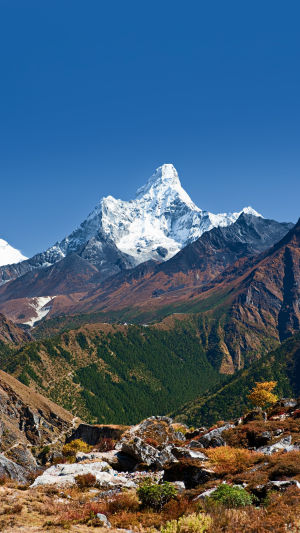Mount Ama Dablam is often called the “Matterhorn of the Himalayas” due to its iconic shape and prominent ridge. Rising to an impressive 6,812 meters (22,349 feet), this peak has captivated climbers for decades.
Although it's overshadowed by giants like Everest, Ama Dablam has its own charm, offering stunning views and a challenging route that demands both physical and mental fortitude.
For those who aren’t looking to tackle Everest but want an adventurous experience, Ama Dablam's base camp trek offers an ideal way to experience high-altitude trekking without the summit’s technical demands!
<h3>Getting There: Planes, Trails, and Tea Houses</h3>
The journey to Ama Dablam begins with a flight into Nepal’s Kathmandu, followed by another flight to Lukla, the gateway to the Everest region. From Lukla, trekkers head along scenic trails to the bustling Namche Bazaar before reaching the base camp. This trek typically costs around $2,000 to $3,000, covering flights, permits, and accommodations at tea houses along the route. This area is known for its Sherpa culture, which you’ll encounter in villages like Pangboche. The route can be a test of stamina as you ascend to 4,600 meters (15,100 feet), but each step is rewarded with breathtaking Himalayan landscapes.
<h3>Challenges and Rewards on the Trail</h3>
For many, the Ama Dablam trek provides a moderately challenging but accessible experience for high-altitude trekking. You’ll encounter some rocky paths and steep ascents, especially as you near the base camp. It’s essential to pace yourself and acclimate slowly to avoid altitude sickness. Though it’s manageable for those in good physical condition, hiring a guide is recommended to navigate the trail safely, as weather and altitude can present unpredictable challenges. The base camp trek is available year-round but is best in the pre-monsoon (March to May) and post-monsoon (September to November) seasons, when the weather is most stable.
FULL AMA DABLAM Climb | 4K
Mark Boelskifte
<h3>The Trekking Experience: What to Expect</h3>
The journey to Ama Dablam’s base camp is as rewarding as the summit itself. Starting from the bustling town of Kathmandu, you'll fly to Lukla - a thrilling start to your adventure. The trek winds through lush rhododendron forests, serene monasteries, and picturesque villages. Daily hikes range from 5 to 8 hours, with breathtaking vistas at every turn. Accommodations typically consist of teahouses, offering cozy lodgings and hearty meals for about $10 per night. Along the way, immerse yourself in the local culture, savoring traditional dishes like dal bhat and interacting with friendly Sherpa families.
<h3>Base Camp Bliss: Life at 4,600 Meters</h3>
The base camp itself, at 4,600 meters, offers panoramic views of Ama Dablam’s hanging glaciers and surrounding peaks, making it a photographer’s dream. Amenities are modest but comfortable: you’ll find tea houses and the occasional hot meal. There are no mountain huts along the trek, so tents are essential, and staying warm in sub-zero conditions is key. The camp serves as an acclimatization spot for climbers aiming for the summit, and it’s also a destination for trekkers looking to experience the sheer grandeur of the Himalayas without tackling the technical climb.
<h3>The Climb: For the Brave and Prepared</h3>
For those interested in summiting Ama Dablam, it’s a 20-25 day endeavor involving steep rock faces, ice climbing, and altitude acclimatization at camps along the ridge. The climb itself is graded at around 5.7 with some crux sections that demand prior climbing experience. It is recommend hiring guides and porters, not only for safety but to help manage logistics. Costs can range from $4,000 to $10,000, depending on the level of support required and the guiding company.
<h3>The Cost Behind The Climb</h3>
Guided climbs can cost upwards of $10,000, which includes permits, guides, porters, and logistics. It’s advisable to train rigorously beforehand, focusing on both endurance and technical climbing prowess. Remember, safety should always be your top priority, so listen to your guides and respect the mountain’s formidable presence
Ama Dablam is as rewarding as it is challenging, offering a mix of natural beauty, cultural immersion, and adventure. Whether you’re aiming for the summit or trekking to base camp, remember that preparation is key. Pack for fluctuating temperatures, take your time to acclimatize, and most importantly, bring a camera! The Himalayas will reward you with memories that will last a lifetime. Before heading off, double-check permit requirements and prepare for potential weather delays in Lukla.





